|
Judas went through with his plan. He knew Jesus well enough to suspect that it would be to the Garden of Gethsemane that he would retreat. It was there that he betrayed his Master with a traitorís kiss. Throughout Thursday night, Jesus stood trial. Pilate ordered Jesus brutally beaten, probably believing that such punishment would satisfy the ugly mob, but it demanded more and Jesus was delivered up to be crucified. "Pilate, having scourged Jesus, delivered Him to them to be crucified -- and they crucified Him." What did the body of Jesus of Nazareth actually endure during those hours of torture? There is archeological evidence that it was the Tau cross, shaped like our T, on which Jesus was crucified. Medieval and Renaissance painters have given us a picture of Christ carrying the entire cross. But the upright post, or stipes, was generally fixed permanently in the ground at the site of execution and the condemned man was forced to carry the cross piece, weighing about 110 pounds, from the prison to the place of execution. A small sign, stating the victim's crime was usually placed on a staff, carried at the front of the procession from the prison, and later nailed to the cross so that it extended above the head. This sign with its staff nailed to the top of the cross would have made it look somewhat like the form of the Latin cross. But, of course, the physical passion of the Christ began in Gethsemane. Of the many aspects of this initial suffering, the one of greatest physiological interest is the bloody sweat. It is interesting that St. Luke, the physician, is the only one to mention this. He says, "And being in an Agony, He prayed more earnestly; and His sweat was as it were great drops of blood, falling down to the ground." KJV This is the description of a rare phenomenon. Under great emotional stress of the kind our Lord suffered, tiny capillaries in the sweat glands can break, thus mixing blood with sweat. After the arrest in the middle of the night, Jesus was brought before the Sanhedrin and Caiphus, the High Priest. A soldier struck Jesus across the face for remaining silent when questioned by Caiphus. The palace guards then blind-folded Him and mockingly taunted Him to identify them as they each passed by, spat upon Him, and struck Him in the face. In the early morning, battered and bruised, dehydrated, and exhausted from a sleepless night, Jesus is taken to the Procurator of Judea, Pontius Pilate. Pilate attempted to pass responsibility to Herod Antipas, the Tetrarch of Judea. Jesus apparently suffered no physical mistreatment at the hands of Herod and was returned to Pilate. It was in response to the cries of the mob, that Pilate ordered Barabbas released and condemned Jesus to scourging and crucifixion. It is believed that Pilate originally ordered Jesus scourged as his full punishment and that the death sentence by crucifixion came only in response to the taunts by the mob that the Procurator was not properly defending Caesar against this pretender who allegedly claimed to be the King of the Jews. Preparations for the scourging were carried out when the Prisoner was stripped of His clothing and His hands tied to a post above His head. It is doubtful the Romans would have made any attempt to follow the Jewish law in this matter, but the Jews had an ancient law prohibiting more than forty lashes. 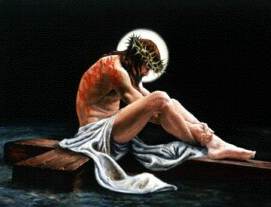 The Roman soldier used a short whip consisting of several heavy, leather thongs with two small balls of lead attached near the ends of each. The heavy whip was brought down with full force again and again across Jesus' shoulders, back, and legs. At first the thongs cut through the skin only. Then, as the blows continued, they cut deeper into the underlying muscles. When it is determined by the centurion in charge that the prisoner is near death, the beating is finally stopped. The half-fainting Jesus was then untied and allowed to slump to the stone pavement, wet with His own blood. The Roman soldiers see a great joke in this provincial Jew claiming to be king. They throw a robe across His shoulders and place a stick in His hand for a scepter. They still need a crown to make their cruel jest complete. Flexible branches covered with long thorns (commonly used in bundles for firewood) were woven into the shape of a crown and pressed into His scalp, causing copious bleeding. 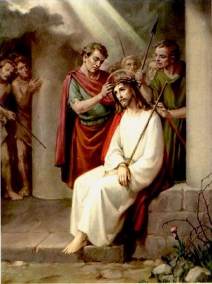 After mocking Him and striking Him across the face, the soldiers take the stick from His hand and strike Him across the head, driving the thorns deeper into His scalp. The robe is torn from His back where it adhered to His wounds, its removal causing excruciating pain. The Romans return His garments in deference to Jewish custom. The heavy cross-beam is tied across His shoulders, and the procession of the condemned Christ, two thieves, and the execution detail of Roman soldiers begins its slow journey along the Via Dolorosa. 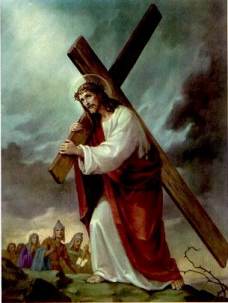 In spite of His efforts to walk erect, the weight of the heavy wooden beam, together with the shock produced by copious blood loss, is too much. He stumbles and falls. He tries to rise, but human muscles have been pushed beyond their endurance.  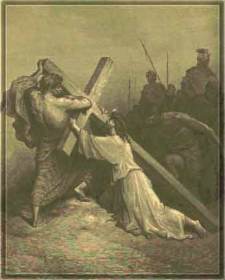 "It was a merciful Jewish practice to give to those led to execution a drink of strong wine mixed with myrrh, a mild analgesic mixture, so as to deaden consciousness". But having tasted it....He would not drink it.....He would meet Death, even in his sternest and fiercest mood, and conquer by submitting to the full punishment. Simon is ordered to place the cross beam on the ground and Jesus quickly thrown backward with His shoulders against the wood. The soldier drives a heavy, square, wrought-iron nail through the wrists and deep into the wood. Historical Roman accounts have established that the nails were driven between the small bones of the wrists and not through the palms. Nails driven through the palms would not support the weight of the human body. The misconception may have come about through a misunderstanding of Jesus' words to Thomas, "Observe my hands". Anatomists, both modern and ancient, have always considered the wrist as part of the hand. 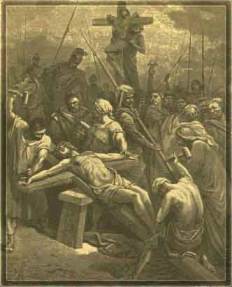 The cross beam is then lifted into place at the top of the stipes and the titulus reading "Jesus of Nazareth, King of the Jews" nailed into place. The left foot was then pressed backward against the right foot, and with both feet extended, a nail driven through the arch of each, leaving the knees slightly flexed. As He slowly sags down with more weight on the nails in the wrists excruciating pain shoots along the fingers and up the arms to explode fierily in the brain. As He pushes Himself upward to avoid this stretching torment, He places His full weight on the nail through His feet. Again there is the searing agony of the nail tearing through the nerves between the bones of the feet. 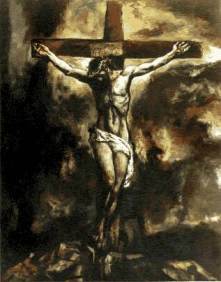 At this point, as the arms fatigue, great waves of cramps sweep over the muscles, knotting them in deep, relentless, throbbing pain. With these cramps comes the inability to push Himself upward. Hanging by His arms, His chest muscles are paralyzed and the intercostal muscles are unable to act. Air can be drawn into the lungs, but cannot be exhaled. Jesus fights to raise Himself in order to get even one short breath. It was likely during these periods that He uttered the seven short sentences recorded: The first, looking down at the Roman soldiers throwing dice for His seamless garment: "Father, forgive them for they know not what they do." The second, to the penitent thief, "Today thou shalt be with me in Paradise." The third, looking down at the terrified, grief-stricken, beloved Apostle John-- he said, 'Behold thy mother." Then, looking to His mother Mary, "Woman behold thy son." The fourth cry is from the beginning of the 22nd Psalm, recorded in Matthew 27:46: "About the ninth hour Jesus cried out in a loud voice, "Eloi, Eloi, lama sabachthani?'--which means, My God, my God, why have you forsaken me?" Isaiah 59:2 says that sins cause a separation from God, and that He hides His face from you so that He does not hear. The Father must turn away from His Beloved Son on the cross. For the first time, Jesus does not address God as His Father. Hours of limitless pain, cycles of twisting, joint-rending cramps, intermittent partial asphyxiation, searing pain where tissue is torn from His lacerated back as He moves up and down against the rough timber. Then another agony begins...A terrible crushing pain deep in the chest as the pericardium slowly fills with serum and begins to compress the heart. One remembers again the 22nd Psalm, the 14th verse: "I am poured out like water, and all my bones are out of joint; my heart is like wax; it is melted in the midst of my bowels." It is now almost over. The loss of tissue fluids has reached a critical level; the compressed heart is struggling to pump heavy, thick, sluggish blood into the tissue; the tortured lungs are making a frantic effort to gasp in small gulps of air. The markedly dehydrated tissues send their flood of stimuli to the brain. Jesus gasps His fifth cry, "I thirst." One remembers another verse from the prophetic 22nd Psalm: "My strength is dried up like a potsherd; and my tongue cleaveth to my jaws; and thou hast brought me into the dust of death." A sponge soaked cheap, sour wine which was the staple drink of the Roman legionaries, is lifted to His lips. He apparently doesn't take any of the liquid. The body of Jesus is now in extremes, and He can feel the chill of death creeping through His tissues. This realization brings out His sixth words, possibly little more than a tortured whisper, "It is finished." His mission of atonement has been completed. Finally He can allow his body to die. With one last surge of strength, he once again presses His torn feet against the nail, straightens His legs, takes a deeper breath, and utters His seventh and last cry, "Father! Into thy hands I commit my spirit." The rest you know. In order that the Sabbath not be profaned, the Jews asked that the condemned men be dispatched and removed from the crosses. The common method of ending a crucifixion was by breaking of the bones of the legs. This prevented the victim from pushing himself upward; thus the tension could not be relieved from the muscles of the chest and rapid suffocation occurred. The legs of the two thieves were broken, but when the soldiers came to Jesus they saw that this was unnecessary. Thus Jesus fulfills one of the prophetic requirements of the Passover Lamb, that not a bone shall be broken.(Exodus 12:46, John 19:36) Apparently to make doubly sure of death, the legionnaire drove his lance through the fifth interspace between the ribs, upward through the pericardium and into the heart. The 34th verse of the 19th chapter of the Gospel according to St. John reports: "And immediately there came out blood and water". That is, there was an escape of water fluid from the sac surrounding the heart, giving postmortem evidence that Our Lord died not the usual crucifixion death by suffocation, but of heart failure (a broken heart) due to shock and constriction of the heart by fluid in the pericardium. This ended the story of the evil which man exhibited toward Man and toward God. It has been a terrible sight, and more than enough to leave us despondent and depressed. How grateful we can be that we have the great sequel in the infinite mercy of God toward man -- at once the miracle of the atonement (at one ment) and the expectation of the triumphant Easter morning.
This beautiful background set is from In His Image. Use the above link to visit there.
Go here if you wish to view an excellent animated vision of Christ's Passion.
|


